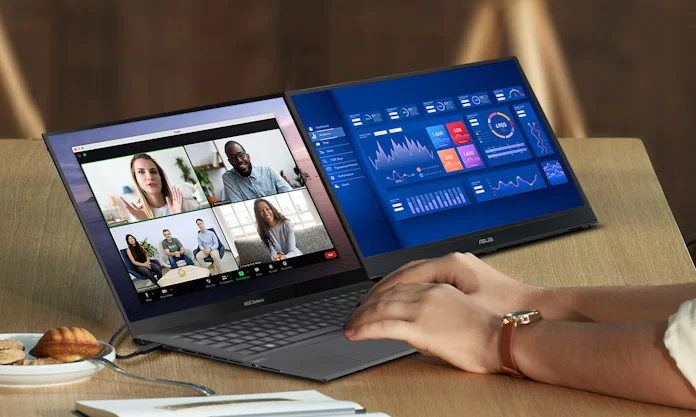When shopping for the best portable monitor, it’s essential to know which features matter most so you end up with a display that’s truly useful and not just flashy.
Introduction
The best portable monitor delivers excellent image quality, connectivity, portability, and usability. Whether you’re working remotely, gaming, designing, or traveling, this guide helps you choose wisely.
What is a portable monitor? How do portable monitors work?
Like any other monitor, a portable monitor has a screen that can be connected to a laptop, desktop PC, gaming console or many other devices. The key difference is that, like the display on a laptop, a portable monitor is exceptionally thin, making it easy to take with you.
You can set up your portable monitor almost anywhere because it has a kickstand. Some portable monitors have a kickstand, which lets you use them in different ways. You can use them in portrait or landscape mode. Their stepless hinge lets you position the display at a wide range of viewing angles, so you can align the portable monitor exactly with the screen of your laptop.
For a deeper understanding, check out our article: [What is a Portable Monitor and Why You Need One]
Brightness, Color Accuracy & Resolution
Brightness above 400 nits ensures decent visibility outdoors or in bright rooms.
For resolution, 1080p (Full HD) is often enough on a 15.6″ display, since pixel density appears sharp. If you need more detail—for video editing or creative work—a 2K or even 4K OLED panel may be worth the price.
OLED portable monitor models like the Innocn 15A1F or ViewSonic VP16‑OLED offer rich colors and contrast, ideal for creators.
Screen Size, Weight & Portability
Portable screen sizes range typically from 13″ to 17″. A 15.6″ model offers the best balance: large enough for productivity yet still fitting into most backpacks.
Weight matters. Choose under 1.5 lb for maximum mobility. Up to 2.5 lb is acceptable if you want extra build quality or features.
Cable and Connectivity Options
Ensure the monitor supports USB-C with DisplayPort Alternate Mode and Power Delivery for one‑cable video and power. Choose models that also include HDMI or mini‑HDMI to connect legacy devices, such as consoles or older laptops.
Some monitors offer DisplayLink support, which lets you use USB‑A ports. However, native Alt‑Mode USB‑C is simpler and more reliable.
Stand Design & Usability Features
Built‑in kickstands or bundled magnetic flip cases should be stable and adjustable. Avoid flimsy clip‑on folios—they often compromise stability and viewing angles.
A stand that supports both landscape and portrait orientation is helpful, especially for coding or document review.
Durable accessories like a carrying case and possible VESA mount compatibility boost portability and desk setup flexibility.
Ergonomics & Extra Features
Monitors with anti‑glare coatings, low‑blue‑light mode, and flicker‑free tech reduce eye strain, especially during long sessions.
If you need touchscreen input or stylus support—check if it’s compatible, especially for Mac—mouse interactions alone might not be enough.
Use Case Scenarios
| Scenario | Key Features | Example Models |
|---|---|---|
| Travel & Productivity | Lightweight, USB‑C single cable | Lenovo ThinkVision M14t Gen 2 |
| Creative or Color‑Sensitive Work | OLED or wide‑gamut panel | Innocn 15A1F, ViewSonic VP16‑OLED |
| Gaming on the Go | High refresh rate (≥144 Hz), battery built‑in | Asus ROG XG17AHPE, ViewSonic VX1755 |
Recommended Models
Lenovo ThinkVision M14t Gen 2
Innocn 15A1F, ViewSonic VP16‑OLED
Asus ROG XG17AHPE, ViewSonic VX1755
Why These Features Matter
The combination of good brightness, accurate color, functional stands, and correct connectivity ensures practical everyday use. Review samples to make sure you’re not getting stuck with unreliable quality from lesser-known brands .
To learn how portable monitors compare to regular displays, check our other article on best computer monitors where we cover resolution, ergonomics, and reviewing criteria links to deeper buying advice.

Leave a Reply